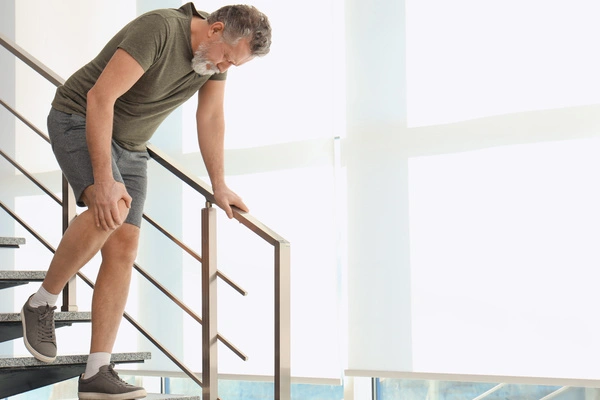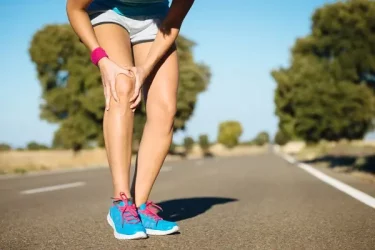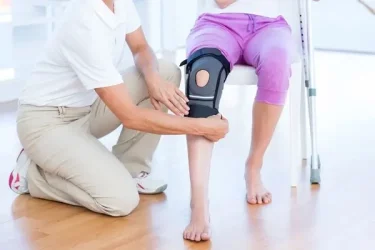Estimated reading time: 5 minutes
Joint pain can be tricky to manage and can stop you from doing the things you love. In this guide, we take a look at the symptoms, effective (and not so!) means of joint pain treatment, and when you should worry about persistent discomfort.

Wellsoon private healthcare
Wellsoon is a service from Practice Plus Group that provides a range of treatments for patients paying for themselves or paying by private medical insurance. With no hidden costs, you’ll pay less than you might think and be back to your best sooner than you thought.
- £95 consultation within 1 to 2 weeks* – includes x-ray, bloods and swabs
- Surgery in just 4 to 6 weeks*
- Experts in hips, knees, eyes, hernias and more
- Pay for yourself or via health insurance
- 0% finance options available

The different types of joint pain explained
Joint pain comes in many different forms. These range from conditions such as bursitis and fibromyalgia, to arthritis and even gout. The type and severity of pain will depend on the underlying issue, as will the effectiveness of chosen treatment.
Common causes of joint pain
The most common causes of joint pain are:
- age-related wear and tear
- injury
- arthritis (osteo and rheumatoid)
- bursitis
- Lyme disease
- tendinitis.
Who can be affected by joint problems and discomfort?
Joint pain caused by injury can affect people of any age. However, conditions that cause joint pain, such as arthritis, are more likely to develop as you get older. Rheumatoid arthritis typically starts to develop from the age of 45 and is more common in women than men.
Common additional symptoms associated with joint pain
Chronic joint pain can be extremely disruptive to your everyday life. It can play havoc with your sleep, stop you from exercising, and even render you unable to carry out simple household chores.
Here are some of the most common symptoms of joint pain to look out for:
- inflammation of the joint (swelling)
- stiffness of the joint
- numbness
- pain when moving
- difficulty bending or straightening the affected joint
- clicking or grinding sound when moving.
When should I worry about joint pain?
You should see a health professional as soon as possible if an injury causes persistent joint pain. If the affected joint looks out of shape, the pain is severe, and the joint is completely immobile, you should also seek medical advice.
Getting diagnosed
At Practice Plus Group, you’ll be diagnosed during your initial consultation. This costs £95 and includes all investigative tests needed to arrive at a diagnosis. The tests will likely range from x-rays and scans to physical examinations and questions about your medical history. Once a diagnosis has been made, your consultant will devise a treatment plan.
How to reduce bone and joint pain at home
There are a few things you can try at home that may help to ease bone and joint pain. The first of which is hot and cold therapy. Ice packs and heating pads are a great way of managing this, but hot and cold baths will also do the trick!
Another way is to practise an effective stretching and strengthening routine. This could be achieved through yoga or pilates classes, or simply learning which exercises work for you.
Other methods to try are:
- losing weight (and then maintaining a healthy weight)
- taking pain medication
- use of supports and braces (if applicable).
Best medicines for joint pain
The first port of call when it comes to treating joint pain with medicine is paracetamol. Generally, nonsteroidal anti-inflammatory drugs (NSAIDS) such as Advil and Ibuprofen can be effective. However, before taking these,it is advisable to seek the opinion of your GP as these drugs can have side effects. These are available over-the-counter at most pharmacies. Joint pain relief creams can also be useful at managing discomfort. The more popular brands include Voltarol and Jointace but it’s worth trying a few to see which works for you.
Do’s and don’ts
The do’s and don’ts of joint pain will generally be guided by your level of discomfort. For example, if you feel comfortable gardening, then by all means get outside and get your fingers green. However, some people won’t feel comfortable gardening with joint pain, so light physical activity such as walking may be more suitable.
In general, the encouraged activities are as follows:
| Do’s | Don’ts |
|---|---|
| Walking | Football |
| Swimming | Rugby |
| Muscle strengthening and stretching | Skiing |
| Yoga | Activities with a high possibility of falling |
Best treatments for joint pain and stiffness
The most effective treatment for joint pain and stiffness will depend on the underlying cause and the level of discomfort. However, below we explore the most common treatments recommended by consultants.
Joint injections
Joint injections are typically performed using ultrasound guidance. These offer real-time imaging of joint spaces and allow for the precise administration of medication into specific anatomical locations.
Physiotherapy for painful joints
In some cases, physical therapy may be an effective form of joint pain management. A physio that specialises in joint care may recommend massage therapy, the use of supports, and a course of muscle strengthening and stretching to help deal with painful joints.
Joint replacement surgery
In severe cases or where other conservative pain management methods have failed, your doctor may recommend surgery.
With Wellsoon from Practice Plus Group, you can have knee or hip replacement surgery in just 4-6 weeks from your initial consultation at a range of UK locations.
Surgery for hip joint pain
In severe cases, hip surgery may be recommended. At Practice Plus Group, this costs £12,549 (plus £95 for the initial consultation). This price is all-inclusive of any investigative tests, potential hospital stays, and any post-surgery care needed.
Surgery for knee joint pain
In cases where conservative pain management has proved ineffective, knee replacement surgery may be recommended. At Practice Plus Group, this costs £13,149 (plus £95 for the initial consultation). This price is all-inclusive of any investigative tests, potential hospital stays, and any post-surgery care needed.
Alternative treatments for joint pain
Surgery is often seen as the last resort when it comes to dealing with joint pain. Although not inevitable, before it gets to this point there are more conservative methods you can try.
Vitamins and supplements for joint pain
Before you rush off to your local Holland & Barrett, it’s worth noting the mixed feedback when it comes to the effectiveness of vitamins and supplements when dealing with joint pain. While glucosamine and chondroitin do have anti-inflammatory benefits, studies show joint supplements have little effect on joint pain caused by arthritis. It’s worth doing some extra research before splashing the cash.
Massage
Massage can prove to be an effective form of managing joint pain, depending on the underlying cause. A good physio will listen while you explain the issue and devise a treatment plan. This will likely involve massage therapy and a muscle stretching and strengthening routine to practise over the course of a period of time.
Find joint pain relief with Wellsoon from Practice Plus Group
At Practice Plus Group Hospitals we’re passionate about giving patients a positive experience and excellent clinical outcomes, with personalised care every step of the way. Whether you’re paying for yourself or using private medical insurance, with our short waiting times, unrivalled Care Quality Commission (CQC) ratings and high levels of cleanliness and infection control, we’ll make sure you’re looked after. In fact, we were the first provider to have all services rated ‘Good’ or ‘Outstanding’ by the CQC.
Joint pain FAQs
Not yet found what you’re looking for? Our dedicated joint pain FAQs can help!
In a word, no. If joint pain is disrupting your everyday activities, you should seek medical advice as soon as you can.
Conditions such as osteoarthritis (wear and tear), rheumatoid arthritis, bursitis, fibromyalgia, and even gout can cause pain in multiple joints.
Yes. Joint pain can be caused by conditions such as fibromyalgia, bursitis, or other soft tissue conditions around the joint.
This depends on the underlying issue. For example, bursitis usually goes away on its own and can be relieved by rest, ice, or medication. For osteoarthritis, there is no cure. The pain can be managed by medication or, in severe cases, surgery.
This is dependent on the underlying cause of joint pain. For example, if you’re suffering from arthritis or gout, there is no known cure. People suffering from bursitis on the other hand will be happy to hear the condition normally resolves itself.
This depends on which source you ask. Promoters of joint supplements will loudly extol their merits, however research indicates their effectiveness is mixed. While glucosamine and chondroitin do have anti-inflammatory benefits, studies show joint supplements have little effect on joint pain caused by arthritis.
This depends on the severity of the pain and the underlying cause. Mild joint pain may respond well to medication or the use of heat and cold therapy. For more severe cases, a doctor may recommend surgery as the best course of action.






